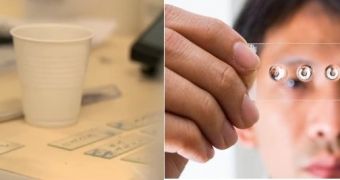Lenses aren't that hard to make from large pieces of glass, but things get progressively harder the smaller we're trying to make the lens, and microlenses are a particularly troublesome kettle of fish.
At least that's what things have been like until the present time. Now, though, we might be on the cusp of a new age of microscopes.
You see, 3D printing technology (or what passes for it) has made it possible to create disposable microscopes that cost only 2 bucks on average.
Researchers from Australia National University, UNSW Australia and the Garvan Institute of Medical Research have come up with a new 3D printing microfluidic methodology.
Essentially, they have created a low-cost fabrication technique for microlenses and microlens arrays that can replace the standard process employed today.
They proved the viability of their creation by building a lens attachment which, when attached to a smartphone, allowed the phone to play the role of a dermascope.
Dermascopes can diagnose deadly skin diseases and usually cost $500 / €361 to make. The phone version can be made for $2 / €1.45.
Well, those are the material costs, but even if the production does demand some payment, it will be tiny, since none of the normal equipment and production steps are required.
To put things into perspective, microlenses and microlens arrays are usually produced through microjet fabrication, electron-beam lithography, molding, photoresist, and hot embossing.
For such a variety of ways, there definitely isn't anything resembling “low cost.” All of them need complex molds, and aren't particularly prone towards dynamic parameter adjustment. Which is to say, they aren't flexible at all.
The new lenses are made from PDMS silicon polymer baked on a standard microscope slide (at 70 degrees Celsius, to harden the material). It costs less than a penny to make each singular lens.
It's a lot like normal FDM printing (fused deposition modeling). A drop of PDMS is placed and hardened, then a second one is dropped over it, assuming a shape like a parabola (aspherical). At that point, all it takes is to bake the PDMS again and voila! The lens is ready. You can even put finishing touches with an accuracy of 2 mm (additional droplets can be added and baked, to affect the curvature).
Add to that some 3D printed mounting hardware and you can make a microscope for everyone at a pittance compared to before. Lenses can be of 12 mm to 50 mm in diameter, with a thickness of a few millimeters. They are capable of 160X magnification and resolution down to about 4 μm, but could get better with every refinement to the manufacturing technique.

 14 DAY TRIAL //
14 DAY TRIAL //